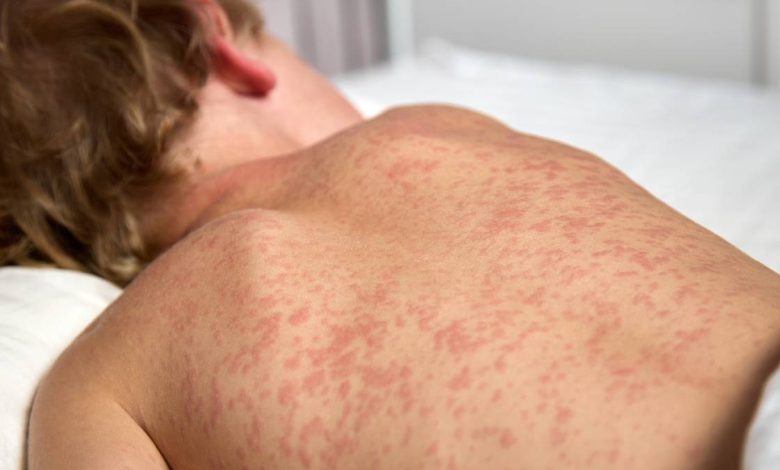Measles Returns: South Carolina Faces New Outbreak, DPH Issues Urgent Warning

Intoduction
A sudden uptick in measles cases in South Carolina’s Upstate region has prompted an urgent public-health response and renewed concern about the re-emergence of a disease once declared eliminated in the United States. The South Carolina Department of Public Health (DPH) confirmed an outbreak in early October 2025 and has since traced multiple cases to communities in and around Spartanburg County. As officials scramble to contain spread, public health experts repeat a familiar message: vaccination is the single most effective defense.
What happened — a quick timeline
The DPH announced its first cluster of cases in the Upstate on Oct. 2, 2025, saying several people had recently fallen ill with measles and that the outbreak was being actively investigated. By Oct. 7, multiple local news outlets were reporting additional confirmed cases, bringing South Carolina’s total for the year to double digits and the Upstate outbreak’s case count rising week by week. Officials have said many of the affected people were unvaccinated, and — worryingly — that at least some cases have no clear source, suggesting local transmission is occurring.
This cluster follows other measles activity nationwide in 2025: the Centers for Disease Control and Prevention (CDC) has been tracking a markedly higher number of measles outbreaks this year compared with recent years, with several states reporting sustained transmission. That national picture makes local containment more urgent: importations from abroad or interstate travel can seed new outbreaks, and communities with pockets of low vaccination coverage are especially vulnerable.
Why this matters: measles is not a trivial illness
Measles is one of the most contagious viruses known. A person with measles can spread the virus to 9 out of 10 susceptible individuals in close contact. The virus travels through respiratory droplets and can linger in the air and on surfaces for up to two hours after an infectious person has left the area. Importantly, individuals are contagious from roughly four days before the characteristic rash appears to about four days after — which means transmission can occur before anyone realizes there is an infection.
For most people, measles causes high fever, cough, runny nose, red watery eyes, and the classic rash. But complications can be severe: pneumonia, encephalitis (brain swelling), and death can occur, especially in very young children, pregnant people, and those with weakened immune systems. Even in otherwise healthy patients, measles can leave a lingering effect on immune memory — temporarily lowering the body’s ability to fight other infections for months. That combination of contagiousness and potential severity is why public health systems aim to prevent any re-establishment of endemic measles.
Who is affected in South Carolina
DPH’s outbreak notices indicate that many — and in several reports, most — of the new cases are among unvaccinated individuals. Initial cases this year included both travel-associated infections and infections linked to close contact with other confirmed cases. The recent Upstate cluster, centered in Spartanburg County, has included cases among people who had no recent travel history, pointing to local circulation of the virus. DPH has set up an outbreak page to share updates and guidance with the public.
Public health investigators are working to identify every exposure, notify people who may have been exposed, and recommend vaccination or post-exposure prophylaxis where appropriate. While DPH has not released personally identifying details about patients (to protect privacy), the public notices are clear about the areas and dates of exposure when possible so people can assess their own risk.
How public health responds to a measles outbreak
When measles returns to a community, the response is rapid and multi-pronged:
- Case identification and contact tracing. Health departments interview confirmed cases to identify where they visited while infectious, then reach out to exposed contacts to advise quarantine, testing, or emergency vaccination.
- Testing and genotyping. Confirmed cases are tested to verify measles infection and sometimes genotyped to understand the strain and links between cases; this helps determine whether infections came from a single introduction or multiple importations.
- Vaccination clinics and targeted outreach. Departments of health often set up vaccination clinics in affected areas and partner with local clinics, schools, and community organizations to increase MMR (measles-mumps-rubella) coverage.
- Public communication. Clear messaging on symptoms, isolation rules, and vaccine availability aims to curb spread and reduce confusion. DPH has emphasized that anyone who is unvaccinated, incompletely vaccinated, or uncertain about their immunity should contact a healthcare provider.
These routine steps are vital because measles can move quickly; a single infectious person in a crowded public space — schools, daycare, college campuses, clinics, or public transit — can expose dozens.
Vaccination: the proven protection
The measles vaccine — given as part of the MMR or MMRV combination — is safe and highly effective. Two doses of MMR provide about 97% protection against measles; one dose provides about 93% protection. When vaccination coverage in a community is high, it creates herd immunity that prevents the virus from finding susceptible hosts and spreading further. Yet gaps in vaccination coverage — whether due to access, misinformation, or other factors — create pockets where measles can take hold.
For anyone unsure about their vaccination status: a quick review of medical records, talking to a primary care provider, or getting tested for measles IgG antibodies can clarify immunity. For children, the CDC recommends the first MMR dose at 12–15 months and a second dose at 4–6 years, with catch-up schedules available for older children and adults who missed doses. During outbreaks, even infants as young as 6 months may receive an early dose of MMR as short-term protection before international travel or in high-risk settings — but this early dose does not replace the routine two-dose series.
Why “Measles Returns” is more than a headline
The phrase “Measles Returns” captures a broader Mental health anxiety: measles was declared eliminated in the U.S. in 2000 thanks to widespread vaccine uptake. Elimination meant there was no continuous endemic transmission — not that the U.S. would never see cases. But the return of outbreaks, especially clustered in under-vaccinated communities, raises the possibility that elimination could be threatened if sustained transmission is allowed to continue. Historically, small numbers of imported cases can be controlled when vaccination coverage is high; when coverage falls below herd immunity thresholds, outbreaks expand.
“Measles Returns” is therefore a call to action: it reminds communities, healthcare providers, schools, and policymakers that the protection offered by vaccines requires maintenance. It also underlines the need to address barriers to vaccination — from access challenges to misinformation — because prevention remains far cheaper, safer, and more humane than treating severe measles complications and mounting outbreak responses.
Practical steps for residents (what you can do right now)
If you live in or near the Upstate or anywhere South Carolina is reporting cases, follow these practical steps:
- Check your vaccination status. If you or your children are unvaccinated or unsure, contact your healthcare provider or local health department. In outbreak settings, timely vaccination can prevent illness.
- Know the symptoms. Measles commonly begins with high fever, cough, runny nose, and red eyes, followed by a spreading rash. If you suspect you or a family member has measles, call your doctor BEFORE you go in — alert them on the phone so they can take precautions to prevent exposing others in waiting rooms.
- Isolate if infected. People with measles should remain isolated for four days after the rash appears; follow public health guidance about when it is safe to return to community settings.
- Be careful around high-risk people. Infants too young for vaccination, pregnant people, and people with compromised immune systems are at higher risk of severe disease. If there are cases nearby, limit their exposure to crowds and ask visitors about their vaccination status.
- Support community vaccination. If you can, encourage workplace or school vaccination drives, share accurate information, and help neighbors access clinics. Community action is decisive in halting outbreaks.
Addressing vaccine hesitancy and misinformation
Vaccine hesitancy has multiple roots: historical mistrust, misinformation spread via social media, religious or philosophical objections, and logistical barriers like time off work or clinic access. Public health officials emphasize transparent communication: acknowledge concerns, provide clear evidence about vaccine safety and effectiveness, and make vaccination convenient and affordable.
Healthcare providers play a critical role; strong provider recommendations are among the most effective strategies to increase vaccine uptake. Local leaders and trusted community organizations can also be powerful messengers — especially in populations where mistrust of government or medical institutions is high. Programs that couple outreach with practical supports (mobile clinics, extended hours, free vaccines) tend to succeed.
The broader context: national trends and what to watch next
2025 has seen higher measles activity in the U.S. compared with recent years, with multiple outbreaks across states. That context matters because outbreaks in any state increase the chance for spread elsewhere via travel; health departments across the country remain on alert. Monitoring by the CDC and state counterparts focuses on case counts, outbreak clusters, and vaccination coverage to prioritize resources.
For South Carolina, key metrics to watch include weekly new cases, whether additional counties report cases, the proportion of cases linked to the known cluster, and whether public health investigators can identify an index case or continue to find unexplained community transmission. DPH’s outbreak page is being updated regularly with the latest situational information and guidance.
What schools and employers should do
Schools and employers are central to outbreak containment:
- Verify immunization records. Schools should review MMR records and follow state rules on exemptions. Where legal, stricter enforcement of vaccination requirements during outbreaks can prevent spread.
- Implement exclusion policies. Unimmunized students exposed to measles may be excluded from school during the incubation period to prevent outbreaks.
- Minimize workplace exposure. Employers should allow sick leave for symptomatic staff and support vaccination access (e.g., onsite clinics or time off for appointments).
- Communicate clearly. Timely messages to parents, staff, and students about symptoms, exposures, and steps to take reduce confusion and delay in seeking care.
These measures, when combined with robust public health follow-up, are effective at limiting outbreaks’ size and duration.
Final thoughts:
The phrase Measles Returns is alarming — and intentionally so. It is a reminder that infectious diseases exploit weaknesses in our defenses. The tools to stop measles are well known: safe, effective vaccines and coordinated public-health action. The recent outbreak in South Carolina’s Upstate demonstrates how quickly the virus can reappear when pockets of susceptibility exist, and how critical it is for communities to act quickly.
If you live in the affected area or plan to travel there, check DPH’s outbreak updates, confirm vaccination status for you and your family, and seek medical advice early if symptoms occur. Containment requires both public systems and private choices — together they decide whether outbreak sparks remain small or ignite broader transmission. Right now, the best response is clear: vaccinate, communicate, and cooperate. Measles can be controlled — but only if communities choose prevention over complacency.




